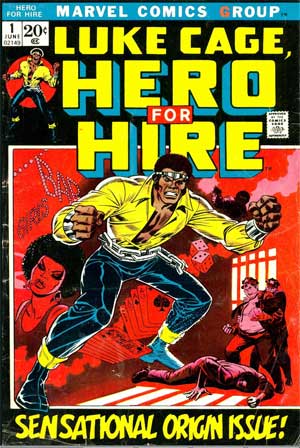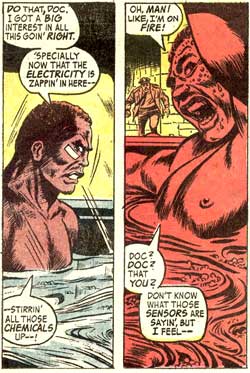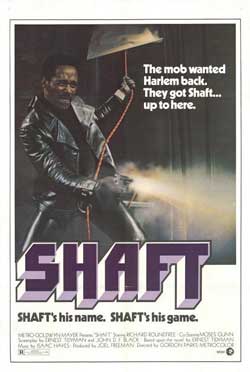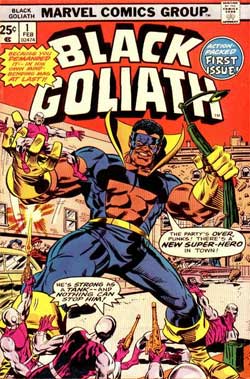 Editor's Note: Today's Bronze Age Spotlight introduces a new writer to the Flashback Universe Team: Crom! Crom is a fiction and film writer for 2nd Culture, an IP creation company. Crom prefers the rocket launcher to the rail gun, Marvel to DC, and Classical to Post-modern. Crom is not a robot from the future, but we're not sure about his illegitimate offspring. You can learn more at his cromunhinged.com.
Editor's Note: Today's Bronze Age Spotlight introduces a new writer to the Flashback Universe Team: Crom! Crom is a fiction and film writer for 2nd Culture, an IP creation company. Crom prefers the rocket launcher to the rail gun, Marvel to DC, and Classical to Post-modern. Crom is not a robot from the future, but we're not sure about his illegitimate offspring. You can learn more at his cromunhinged.com.A risk inherent to reading the 1970’s Luke Cage, AKA Powerman, in this day and age is having one’s mind exploded by an overload of stereotypes, dialogue and cliches which run from quaint to outright racist
The story begins with our protagonist (who seems to only be called Lucas in the first story), very black, and very in jail, (it's okay though, he was framed). There is hope for his release... not through his innocence, but as a White Doctor’s guinea pig. The Doctor offers to experiment on Lucas' body in exchange for a full pardon... just kidding, more like vague promises. This experiment could cure the seriously ill, even stop the aging process. But why try it on the old, or the ill when perfectly healthy, mid-twenties Black men are abundant in maximum security prisons?
 As it does with all comic book Doctors willing to subject human beings to experiments, things turn to the ridiculous... and for Lucas, add 30 CCs more racism.
As it does with all comic book Doctors willing to subject human beings to experiments, things turn to the ridiculous... and for Lucas, add 30 CCs more racism.Bathing in the salty brine of the "electro-chemical solution", Lucas is confronted by his token prison oppressor, Rackham - the red-neck advocate of the issue. Intent on frying our hero, he hatefully twists the special science-knobs. The searing chemicals penetrate Lucas's body, and from the hate-stew emerged Whitey's ironic nightmare: steely skinned Luke Cage - Blacker ‘an ever.
With one mighty swing of his powerful cliche, Lucas smashes his way free of the miracle healing/death chamber, and keeps on punching till he’s escaped prison. Now a drifter, Lucas makes his way back to New York, to Harlem, and the streets he grew up on. And after beating the living shit out of a random kid, decides that New York needs his super powered skills as a private dick.
Seriously - after picking up the pieces of my mind, I thought about how this story could have came into being...
 When 1972 hit, the blaxploitation movement was getting a full head of steam. The previous year had yielded two of the biggest films to make the scene: Sweet Sweetback’s Badass Song and the more well known Shaft. The Black badass had arrived. It was an archetype soon placed into mass production.
When 1972 hit, the blaxploitation movement was getting a full head of steam. The previous year had yielded two of the biggest films to make the scene: Sweet Sweetback’s Badass Song and the more well known Shaft. The Black badass had arrived. It was an archetype soon placed into mass production.Archie Goodwin probably woke up screaming in bed, one spring morning. The gravy train of Blaxploitation was pulling away from the platform, and Archie needed to dive for the caboose. Luke Cage was born.
Marvel had been no stranger to the Black Super Hero. Two major Black characters had already set the stage. The Prowler; a villain from the Spider Man gallery; intriguing in his own way. His costume had a unique flavour, and unlike many of Parker’s other villains, wasn’t absurdly zoomorphic. The other was The Black Panther, the next property in line to be ruined by Wesley Snipes.
But The Prowler and Black Panther were Black characters with strong characteristics and a clear vision. Our man Luke Cage was a cat of another stripe.
Where The Black Panther traded on strong roots into the cultural history of African origins, and a moral ideal for Black and White people alike, Luke Cage was a pop culture Frankenstein. As I read Hero For Hire, I was more and more inclined to think of the main character not as the edgy protagonist that blaxploitation such as Shaft could create, but instead as a caricature of that protagonist through the eyes of the whitest boy to ever come out of Kansas City. Goodwin’s premiere tale in “Luke Cage: Hero For Hire” feels like a suburban distillation of the civil rights movement as seen from the back of a theater.
With Archie Goodwin’s death in 1998, and Stan Lee now an animatronic film extra, it’s unlikely we could ever get a straight account of what prompted Marvel to create Luke Cage. The obvious answer is that Goodwin was secretly Black, and decided that the forum of Marvel was his Mount Sinai.
The whole affair feels clumsy and awkward, like an ill-conceived publishing stunt, perpetrated on the naive white teens who watched movies like Shaft, Black Belt Jones, Sweet, and assumed they were reading Anthropology textbooks.
The backstory of a wrongly accused, young Black man, abused in jail by white supremacist guards is nearly prototypical. The metaphorical language of his ascension to power is clunky. The writing is confused, as if written in the late hours while caging lines from Richard Roundtree. Their turning point takes place in a hot tub. For the love of god.
 However, let's give Marvel credit for publishing a comic with a black hero as the star and resisting the urge to use the word Black in the title. You KNOW they just wanted to call him Black Power Man. (Which is probably how he ended up with the name of Power Man later on.)
However, let's give Marvel credit for publishing a comic with a black hero as the star and resisting the urge to use the word Black in the title. You KNOW they just wanted to call him Black Power Man. (Which is probably how he ended up with the name of Power Man later on.)On the flipside - whatever voice of reason inspired them to forego this annoying tradition seems to have left them two years later, as issue 24 of Power Man of sees the long awaited arrival of Black Goliath. :\
Artistically, the artwork of George Tuska and Billy Graham, like most everything else about the comic, was extremely competent, but hardly revolutionary. Before we completely dismiss the lot of them though, we should remember that they were never given a lot of time to find the characters, or the heart of their story. Goodwin was replaced after five issues by Steve Englehart, and he was only able to get another sixteen out before the series was re-imagined.
The departure of Goodwin and arrival of Steve Englehart on the title prompted a fall into the classic comic mold; oddly shaped midgets in goofy costumes, trying to steal famous diamonds. The social commentary, already thinly scraped across the toast of the narrative, was gone. Now the jive-talking, the street knowledge and the trappings of The Black Power Movement had been bussed out of the comic.
Like the movies, blaxploitation in comics was a quickly killed fad. The book only lasted another fifty issues, when the character was joined with another Marvel cult hero, giving rise to “Powerman & Iron Fist”. The attempt to jiu-jitsu the status of Black people from their martyrdom into heroes was a step along a social path to equality, but it possessed all the nutrition of cotton candy with maple syrup. Fortunately with the team-up, Luke Cage was nursed along for many years until he would later find a solid narrative, with interesting people, and a rich spirituality in the hands of other writers.
Which will no doubt be ruined by Snipes in the future.

4 comments:
Um, George Tuska had been a comic book artist since the early 1940s, hardly a "young" artist.
Doh! Thank you Cash for catching that! What's sad is I was reading about Tuska about a month ago working during the golden age, so I really should have caught that!
I've ammended that part to be more valid. :)
Great article!
The hot tub joke was a riot!
Post a Comment